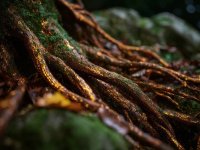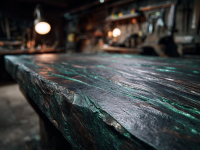Tenacite
Physical Characteristics
| Designation | Root |
| Biome | Forest and Wetlands |
| Colouration | Bronze |
| Distinctions | Smooth outer bark that is a dull grey-green, with bronze streaking. |
Overview
Tenacite is not a true mineral ore but a bio-organic metallophyte native to Yankun’s Galian forests and the upper wetlands of The Ruvira Expanse.It is a root-based organism that naturally absorbs trace metallic elements from soil and binds them into its lignin structure.
When properly treated, its fibrous tissues calcify into a metal-like composite with the same properties as forged alloys: tensile strength, elasticity, and remarkable durability.
- Appearance: Thick, rope-like roots ranging from 5–12 cm in diameter; outer bark smooth and dull grey-green, with bronze streaking.
- Core Tissue: Metallic sheen even while alive; cross-sections reveal fibrous veins that shimmer under light.
- Growth Habit: Subterranean web systems that can extend for kilometers, often symbiotic with iron-rich fungi.
- Scent: Ozone and damp stone, unusually inorganic for vegetation.
- Lignin Matrix: High carbon polymer network similar to cellulose, but interwoven with chelated metal ions.
- Metallic Load: Up to 70% elemental content.
- Silicate Shells: Root epidermis incorporates fine silica layers, lending abrasion resistance.
- Resin Channels: Filled with conductive sap, trace electrogenic compounds used for internal nutrient transport.
- Harvest: Roots are cut at maturity (approx. 20–25 standard years) and cured in nutrient-free soil to purge organic moisture.
- Stabilization: Sap channels are infused with vaporized borosilicates; this triggers bio-mineral ossification, the tissue “turns to metal.”
- Carbon Fixation: High-heat treatment (sub-fusion, non-industrial) carbonizes the organic matrix, binding metallic ions into solid metallic fibers.
- Annealing: The result is solid Tenacite Rootmetal, fully metallic yet still showing faint fibrous patterning from its biological origin.
Trait | Value / Description |
|---|---|
Density | 6.9 g/cm³ |
Tensile Strength | 2.1–2.5 GPa |
Elasticity | Moderate; flexes before fracturing |
Corrosion Resistance | Excellent (silica-carbon passivation) |
Electrical Conductivity | Low to moderate |
Thermal Behaviour | Maintains structural integrity up to ~700°C |
Colour | Dark grey with subtle green fibrous grain (“woodgrain metal”) |
- Soil Renewal: Extracts toxic metals, purifying groundwater, a natural detoxifier turned industrial asset.
- Symbiosis: Roots share nutrients with iron fungi that glow faintly at night, leading locals to call them “Lantern Roots.”
- Post-Nuclear Mutation: In Yankun’s ruined former capital, mutated Tenacite species exhibit accelerated mineralization, growing metallic vines that coil around derelict structures. It is not yet researched whether this means that they also absorb and take part in the radioactivity in the area, making potential harvesting dangerous.
Application | Description |
|---|---|
Slave Collar Frames | Rootmetal fibers can be woven into seamless bands before full calcification produces flexible but highly durable collars. |
Armour Components | Treated Tenacite retains organic elasticity, making it resistant to fracture under kinetic stress. |
Restraint Chains & Shackles | Lighter than Durasteel, extremely resistant to corrosion in humid climates. |
Strain | Environment | Distinguishing Features |
|---|---|---|
Tenacite Prime | Galia Forests | Standard rootmetal, most stable form. |
Tenacite Lux | Ruvira wetlands | Contains luminescent fungal symbionts; prized for decorative alloys. |
Tenacite Ferrum | Ruins of Port Tziu | Higher metal load, brittle but denser. |
Application | Description |
|---|---|
Jewellery | Can be used to create various items of jewellery given the flexibility of pre-carbon fixation Tenacite. Tenacite Lux is popular due to its luminescent properties. |


